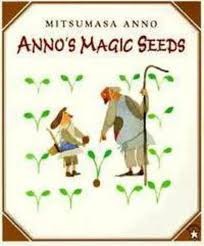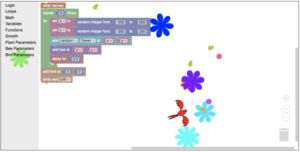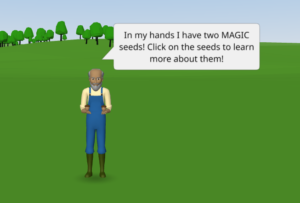The Math of Growing Patterns + Magic Seeds

Mitsumasa Anno wrote the wonderful children’s story called Anno’s Magic Seeds.

The stop-motion animation below depicts one of the growing patterns in the story.
The stop motion animation, along with the content on this page, were created by Adrianna Boersen, Michael Grant & Shannon McDonald (teacher candidates at Western University), with the help of Dr. Rosa Cendros.
Stop Motion Animation Process
We started with a full storyboard that went frame by frame and had the different scenes as well as talking points mapped out. The whiteboard allowed us creative freedom when it came to the creation of the background scene so that the picture was a little more interesting.
- Set up White Board (Tip: use corner of table as frame of reference in case the board gets moved at all)
- Set up Tripod on Floor (so it doesn’t get bumped). We used a professional camera tripod.
- Tape phone onto tripod (or use one that clips into tripod).
- We taped out the area of the whiteboard that could be captured by the camera so that we knew what would be in the scene, this was also helpful if the tripod was ever bumped or we needed to reset the camera.
- Used whiteboard markers to create title sequence (in this case we had seeds sprouting letters) which allowed us to erase and make the letters look more interesting visually.
- We used cut-out characters from the first video and added the background scene with whiteboard markers. We also used whiteboard markers to add text when required (for speech or thought bubbles), which we found saved us a lot of time rather than using paper cutouts.
- To show the passing of time, we drew the background to reflect the changing seasons, we also used post it notes to show that months were passing (each post it was numbered for a day of the month).
- We edited, added music and text to help move the story along using Corel Video Studio (free trial)
*Notes:
- The whiteboard certainly allowed for creativity when it came to drawing the scenes, however we had to be very careful not to erase anything when leaning on it. Also, the whiteboard reflected light so it is important to make sure that each image is in focus and not affected by the camera flash.
- The whiteboard is probably the best when it comes to speech and writing text, however we found that paper or cut-outs as the background may be more interesting visually.
In conclusion, stop motion animation can be time-consuming but the end result is very satisfying. When using in a classroom, students can become creators instead of consumers and this is a great way for students to demonstrate and consolidate their learning, work as part of a group, and get their creative juices flowing.
Ultimately, this project gives students an opportunity to experience math aesthetically; something that they can share with their friends and family and deepen their connection to their learning.
Creating a CoSpace to visualize seeds growth
We also did a 3D interactive animation using CoSpaces, check it out by clicking on the image below.
CoSpaces is a free, cloud-based 3D virtual reality creation environment. We programmed the interactions using a visual programming language (similar to Scratch).
Creating both a stop-motion video and a 3D interactive environment is an example of transmediation, where the story is told through a combination of media platforms, each seeking to add something new to the story. It’s an additional way to engage in the idea of the exponential growth through the story of Anno’s Magic Seeds.
Looking for ideas to apply Anno’s Magic Seeds in your classroom? Here’s an Example Lesson Plan for Grade 4
 See also this math + coding app on Sustainable Growth: http://eduapps.ca/civilization/growth
See also this math + coding app on Sustainable Growth: http://eduapps.ca/civilization/growth

